Founded in 1938 and published semiannually by Sophia University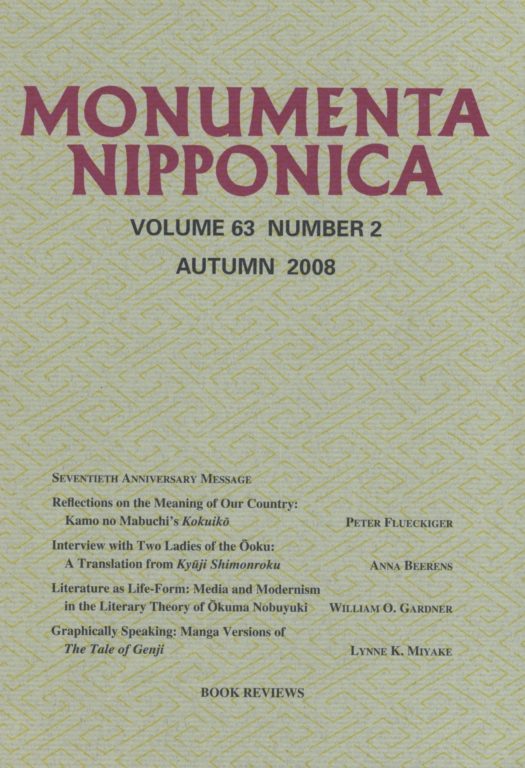 MN 63:2 (2008) 359–92Graphically Speaking: Manga Versions of The Tale of GenjiLynne K. Miyake
MN 63:2 (2008) 359–92Graphically Speaking: Manga Versions of The Tale of GenjiLynne K. Miyake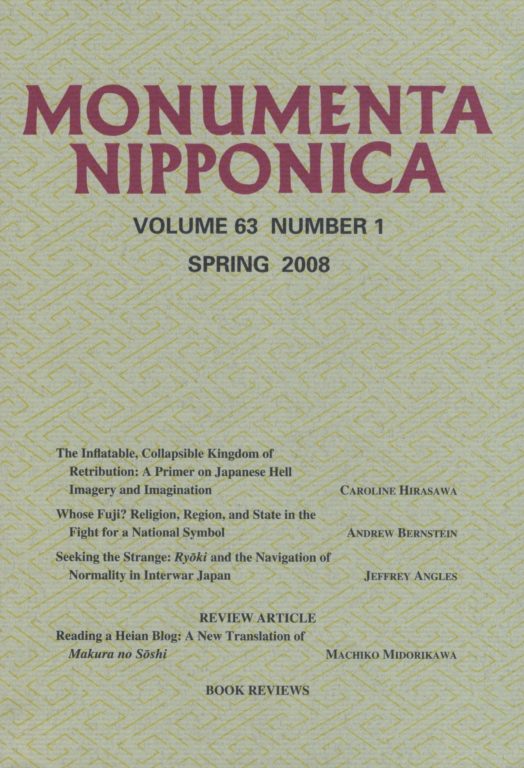 MN 63:1 (2008) 1–50The Inflatable, Collapsible Kingdom of Retribution: A Primer on Japanese Hell Imagery and ImaginationCaroline Hirasawa
MN 63:1 (2008) 1–50The Inflatable, Collapsible Kingdom of Retribution: A Primer on Japanese Hell Imagery and ImaginationCaroline Hirasawa MN 63:1 (2008) 51–99Whose Fuji?: Religion, Region, and State in the Fight for a National SymbolAndrew Bernstein
MN 63:1 (2008) 51–99Whose Fuji?: Religion, Region, and State in the Fight for a National SymbolAndrew Bernstein MN 63:1 (2008) 101–41Seeking the Strange: Ryōki and the Navigation of Normality in Interwar JapanJeffrey Angles
MN 63:1 (2008) 101–41Seeking the Strange: Ryōki and the Navigation of Normality in Interwar JapanJeffrey Angles MN 63:1 (2008) 143–60Reading a Heian Blog: A New Translation of Makura no SōshiMachiko Midorikawa
MN 63:1 (2008) 143–60Reading a Heian Blog: A New Translation of Makura no SōshiMachiko Midorikawa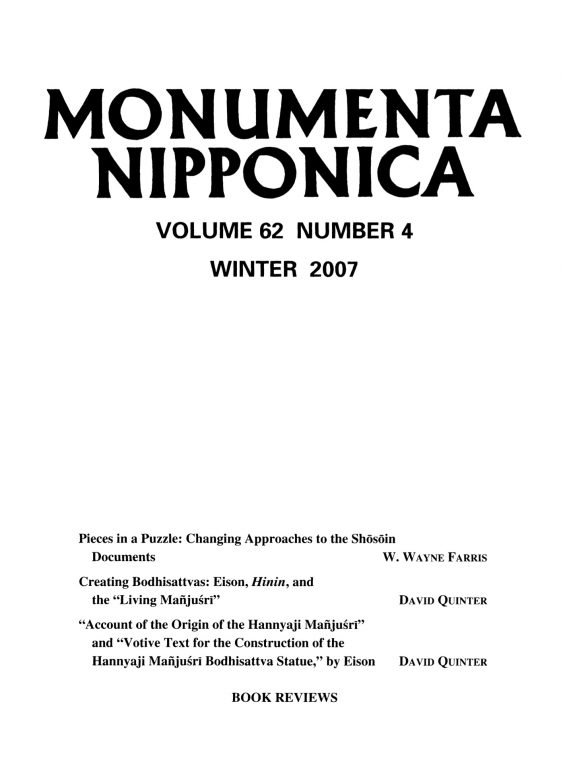 MN 62:4 (2007) 397–435Pieces in a Puzzle: Changing Approaches to the Shōsōin DocumentsWilliam Wayne Farris
MN 62:4 (2007) 397–435Pieces in a Puzzle: Changing Approaches to the Shōsōin DocumentsWilliam Wayne Farris MN 62:4 (2007) 437–79Creating Bodhisattvas: Eison, Hinin, and the “Living Mañjuśrī”David Quinter
MN 62:4 (2007) 437–79Creating Bodhisattvas: Eison, Hinin, and the “Living Mañjuśrī”David Quinter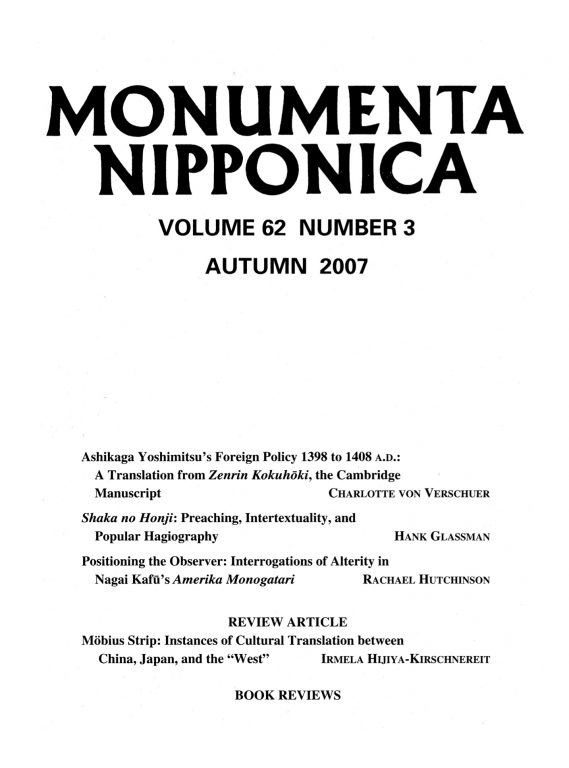 MN 62:3 (2007) 261–97Ashikaga Yoshimitsu’s Foreign Policy 1398 to 1408 A.D.: A Translation from Zenrin Kokuhōki, the Cambridge ManuscriptCharlotte von Verschuer
MN 62:3 (2007) 261–97Ashikaga Yoshimitsu’s Foreign Policy 1398 to 1408 A.D.: A Translation from Zenrin Kokuhōki, the Cambridge ManuscriptCharlotte von Verschuer MN 62:3 (2007) 299–321Shaka no Honji: Preaching, Intertextuality, and Popular HagiographyHank Glassman
MN 62:3 (2007) 299–321Shaka no Honji: Preaching, Intertextuality, and Popular HagiographyHank Glassman MN 62:3 (2007) 323–45Positioning the Observer: Interrogations of Alterity in Nagai Kafū’s Amerika MonogatariRachael Hutchinson
MN 62:3 (2007) 323–45Positioning the Observer: Interrogations of Alterity in Nagai Kafū’s Amerika MonogatariRachael Hutchinson MN 62:3 (2007) 347–60Möbius Strip: Instances of Cultural Translation between China, Japan, and the “West”Irmela Hijiya-Kirschnereit
MN 62:3 (2007) 347–60Möbius Strip: Instances of Cultural Translation between China, Japan, and the “West”Irmela Hijiya-Kirschnereit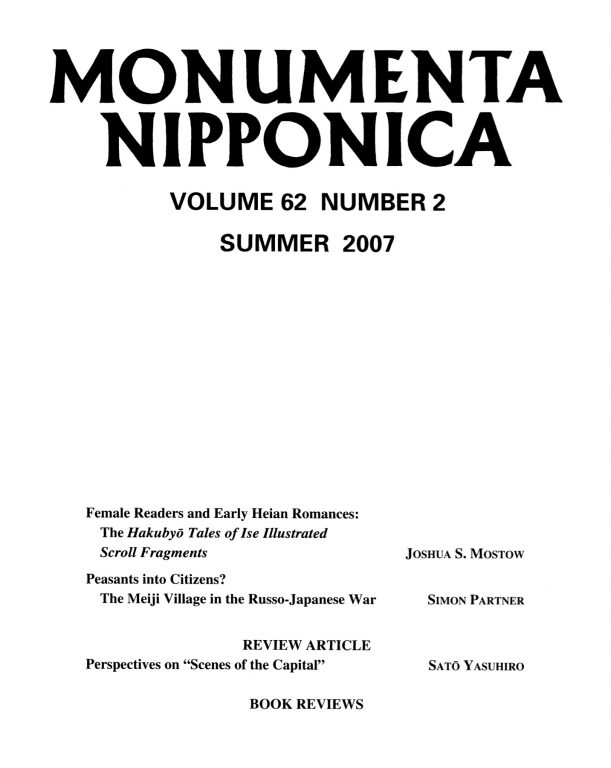 MN 62:2 (2007) 135–77Female Readers and Early Heian Romances: The Hakubyō Tales of Ise Illustrated Scroll FragmentsJoshua S. Mostow
MN 62:2 (2007) 135–77Female Readers and Early Heian Romances: The Hakubyō Tales of Ise Illustrated Scroll FragmentsJoshua S. Mostow MN 62:2 (2007) 179–209Peasants into Citizens?: The Meiji Village in the Russo-Japanese WarSimon Partner
MN 62:2 (2007) 179–209Peasants into Citizens?: The Meiji Village in the Russo-Japanese WarSimon Partner MN 62:2 (2007) 211–19Perspectives on “Scenes of the Capital”Yasuhiro Satō
MN 62:2 (2007) 211–19Perspectives on “Scenes of the Capital”Yasuhiro Satō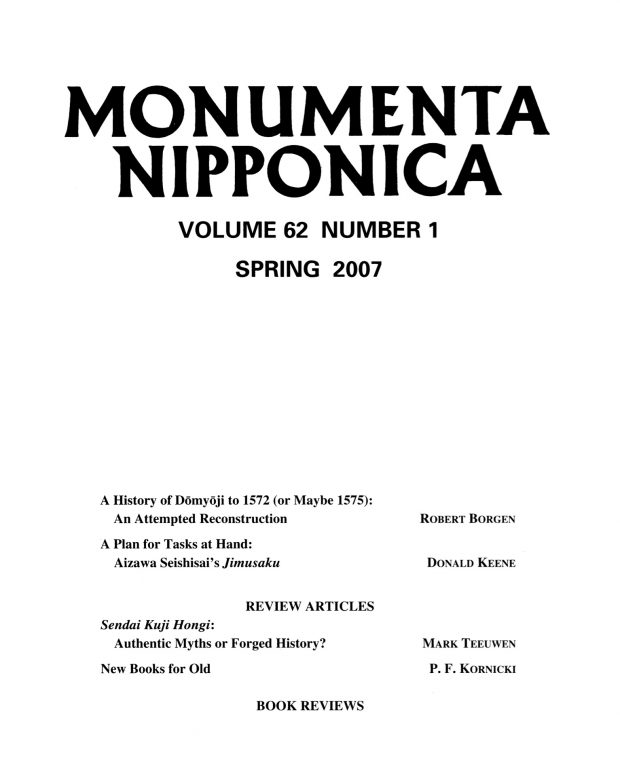 MN 62:1 (2007) 1–74A History of Dōmyōji to 1572 (or Maybe 1575): An Attempted ReconstructionRobert Borgen
MN 62:1 (2007) 1–74A History of Dōmyōji to 1572 (or Maybe 1575): An Attempted ReconstructionRobert Borgen MN 62:1 (2007) 75–86A Plan for Tasks at Hand: Aizawa Seishisai’s JimusakuDonald Keene
MN 62:1 (2007) 75–86A Plan for Tasks at Hand: Aizawa Seishisai’s JimusakuDonald Keene MN 62:1 (2007) 87–96Sendai Kuji Hongi: Authentic Myths or Forged History?Mark Teeuwen
MN 62:1 (2007) 87–96Sendai Kuji Hongi: Authentic Myths or Forged History?Mark Teeuwen MN 62:1 (2007) 97–105New Books for OldPeter F. Kornicki
MN 62:1 (2007) 97–105New Books for OldPeter F. Kornicki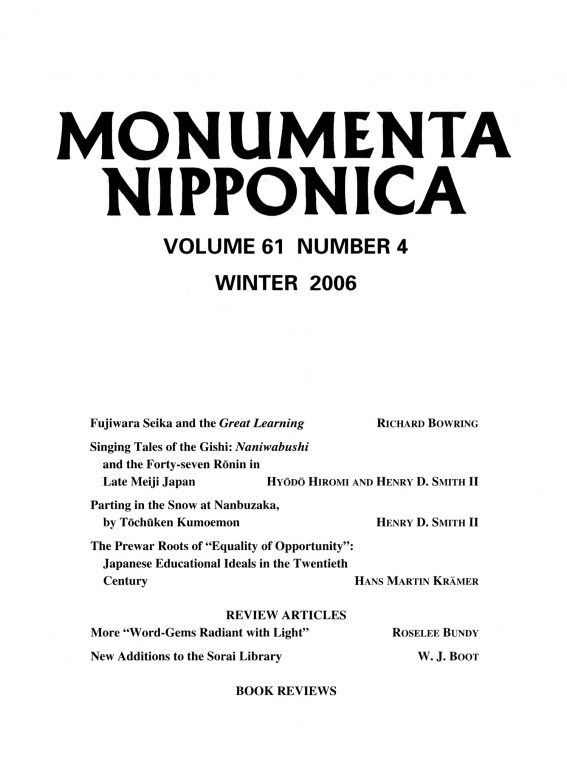 MN 61:4 (2006) 437–57Fujiwara Seika and the Great LearningRichard Bowring
MN 61:4 (2006) 437–57Fujiwara Seika and the Great LearningRichard Bowring MN 61:4 (2006) 459–508Singing Tales of the Gishi: Naniwabushi and the Forty-seven Rōnin in Late Meiji JapanHenry D. Smith II and Hiromi Hyōdō
MN 61:4 (2006) 459–508Singing Tales of the Gishi: Naniwabushi and the Forty-seven Rōnin in Late Meiji JapanHenry D. Smith II and Hiromi Hyōdō MN 61:4 (2006) 521–549The Prewar Roots of “Equality of Opportunity”: Japanese Educational Ideals in the Twentieth CenturyHans Martin Krämer
MN 61:4 (2006) 521–549The Prewar Roots of “Equality of Opportunity”: Japanese Educational Ideals in the Twentieth CenturyHans Martin Krämer MN 61:4 (2006) 551–558More “Word-Gems Radiant with Light”Roselee Bundy
MN 61:4 (2006) 551–558More “Word-Gems Radiant with Light”Roselee Bundy MN 61:4 (2006) 559–566New Additions to the Sorai LibraryW. J. Boot
MN 61:4 (2006) 559–566New Additions to the Sorai LibraryW. J. Boot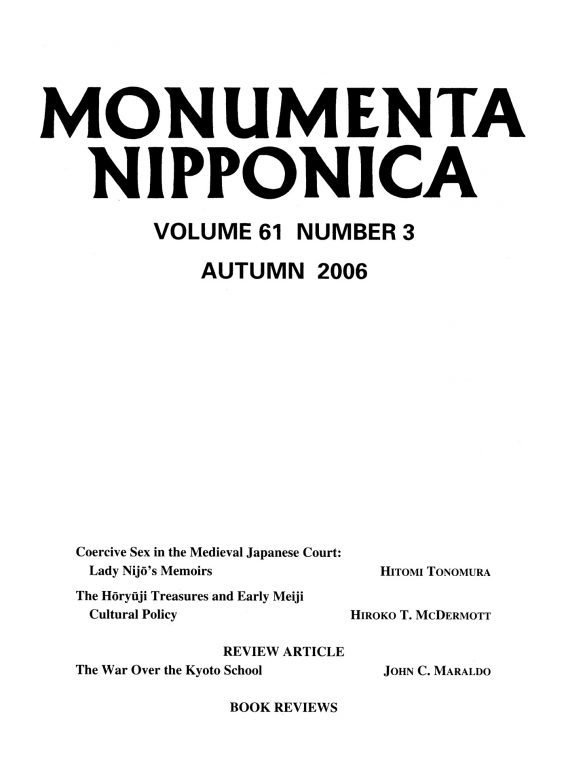 MN 61:3 (2006) 283–338Coercive Sex in the Medieval Japanese Court: Lady Nijō’s MemoirHitomi Tonomura
MN 61:3 (2006) 283–338Coercive Sex in the Medieval Japanese Court: Lady Nijō’s MemoirHitomi Tonomura MN 61:3 (2006) 339–74The Hōryūji Treasures and Early Meiji Cultural PolicyHiroko T. McDermott
MN 61:3 (2006) 339–74The Hōryūji Treasures and Early Meiji Cultural PolicyHiroko T. McDermott MN 61:3 (2006) 375–406The War Over the Kyoto SchoolJohn C. Maraldo
MN 61:3 (2006) 375–406The War Over the Kyoto SchoolJohn C. Maraldo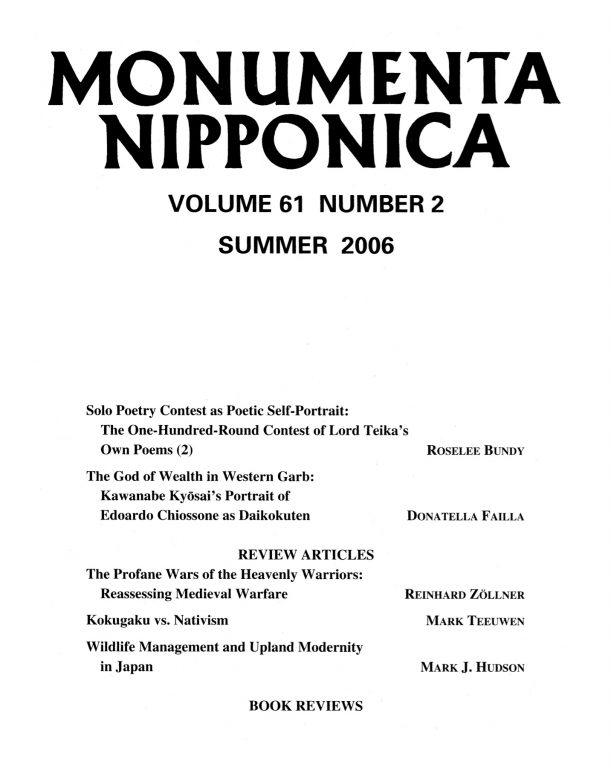 MN 61:2 (2006) 131–92Solo Poetry Contest as Poetic Self-Portrait: The One-Hundred-Round Contest of Lord Teika’s Own Poems (Part 2)Roselee Bundy
MN 61:2 (2006) 131–92Solo Poetry Contest as Poetic Self-Portrait: The One-Hundred-Round Contest of Lord Teika’s Own Poems (Part 2)Roselee Bundy MN 61:2 (2006) 193–218The God of Wealth in Western Garb: Kawanabe Kyōsai’s Portrait of Edoardo Chiossone as DaikokutenDonatella Failla
MN 61:2 (2006) 193–218The God of Wealth in Western Garb: Kawanabe Kyōsai’s Portrait of Edoardo Chiossone as DaikokutenDonatella Failla MN 61:2 (2006) 219–26The Profane Wars of the Heavenly Warriors: Reassessing Medieval WarfareReinhard Zöllner
MN 61:2 (2006) 219–26The Profane Wars of the Heavenly Warriors: Reassessing Medieval WarfareReinhard Zöllner MN 61:2 (2006) 227–42Kokugaku vs. NativismMark Teeuwen
MN 61:2 (2006) 227–42Kokugaku vs. NativismMark Teeuwen MN 61:2 (2006) 243–49Wildlife Management and Upland Modernity in JapanMark J. Hudson
MN 61:2 (2006) 243–49Wildlife Management and Upland Modernity in JapanMark J. Hudson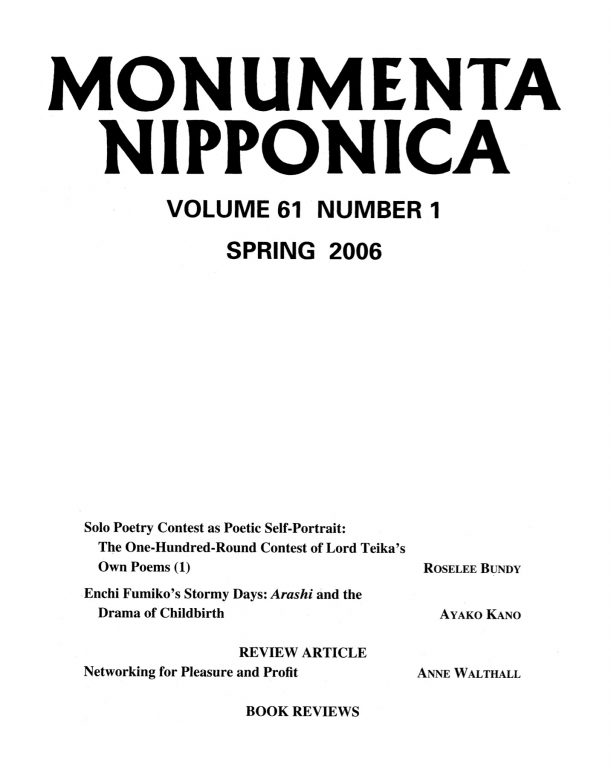 MN 61:1 (2006) 1–58Solo Poetry Contest as Poetic Self-Portrait: The One-Hundred-Round Contest of Lord Teika’s Own Poems (Part 1)Roselee Bundy
MN 61:1 (2006) 1–58Solo Poetry Contest as Poetic Self-Portrait: The One-Hundred-Round Contest of Lord Teika’s Own Poems (Part 1)Roselee Bundy MN 61:1 (2006) 59–91Enchi Fumiko’s Stormy Days: Arashi and the Drama of ChildbirthAyako Kano
MN 61:1 (2006) 59–91Enchi Fumiko’s Stormy Days: Arashi and the Drama of ChildbirthAyako Kano MN 61:1 (2006) 93–103Networking for Pleasure and ProfitAnne Walthall
MN 61:1 (2006) 93–103Networking for Pleasure and ProfitAnne Walthall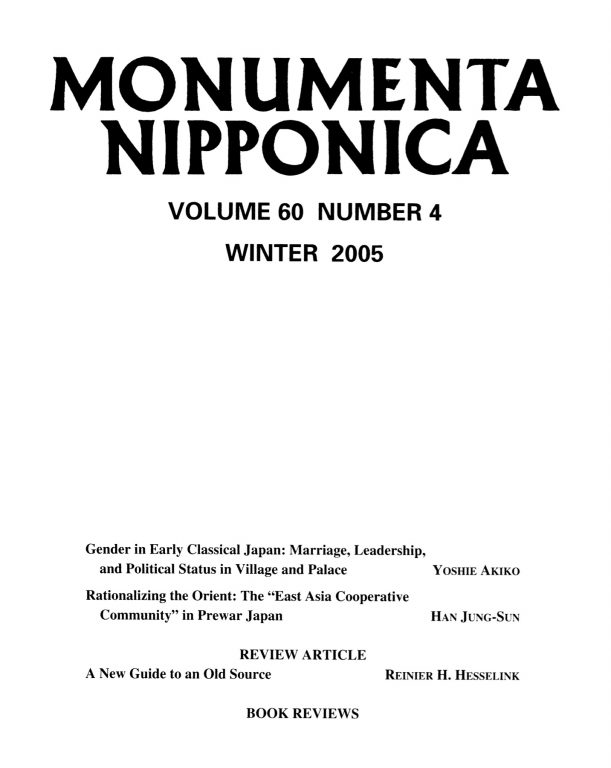 MN 60:4 (2005) 437–79Gender in Early Classical Japan: Marriage, Leadership, and Political Status in Village and PalaceAkiko Yoshie and Janet R. Goodwin
MN 60:4 (2005) 437–79Gender in Early Classical Japan: Marriage, Leadership, and Political Status in Village and PalaceAkiko Yoshie and Janet R. Goodwin MN 60:4 (2005) 481–514Rationalizing the Orient: The “East Asia Cooperative Community” in Prewar JapanHan Jung-Sun
MN 60:4 (2005) 481–514Rationalizing the Orient: The “East Asia Cooperative Community” in Prewar JapanHan Jung-Sun MN 60:4 (2005) 515–523A New Guide to an Old SourceReinier H. Hesselink
MN 60:4 (2005) 515–523A New Guide to an Old SourceReinier H. Hesselink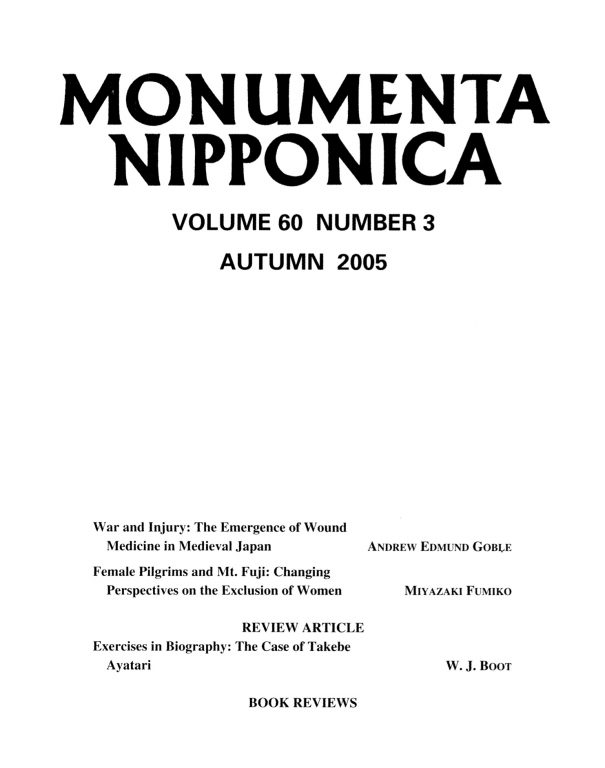 MN 60:3 (2005) 297–338War and Injury: The Emergence of Wound Medicine in Medieval JapanAndrew Edmund Goble
MN 60:3 (2005) 297–338War and Injury: The Emergence of Wound Medicine in Medieval JapanAndrew Edmund Goble MN 60:3 (2005) 339–91Female Pilgrims and Mt. Fuji: Changing Perspectives on the Exclusion of WomenFumiko Miyazaki
MN 60:3 (2005) 339–91Female Pilgrims and Mt. Fuji: Changing Perspectives on the Exclusion of WomenFumiko Miyazaki MN 60:3 (2005) 393–407Exercises in Biography: The Case of Takebe AyatariW. J. Boot
MN 60:3 (2005) 393–407Exercises in Biography: The Case of Takebe AyatariW. J. Boot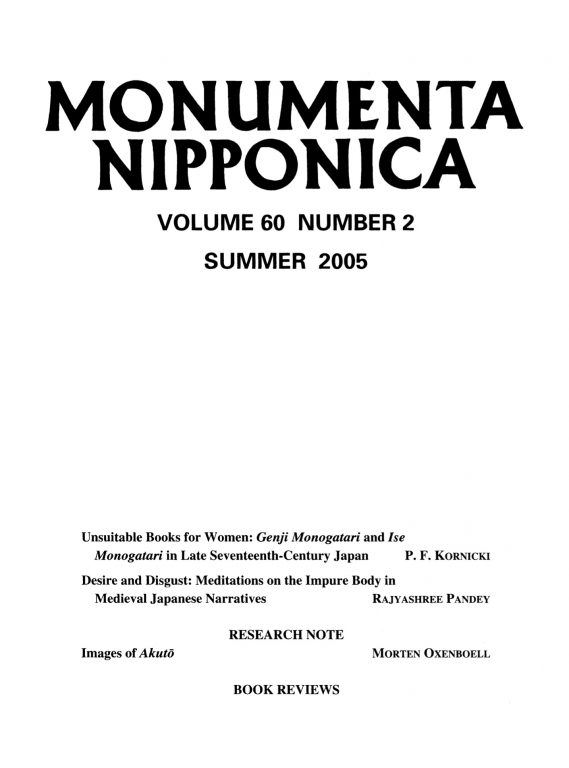 MN 60:2 (2005) 147–93Unsuitable Books for Women?: Genji Monogatari and Ise Monogatari in Late Seventeenth-Century JapanPeter F. Kornicki
MN 60:2 (2005) 147–93Unsuitable Books for Women?: Genji Monogatari and Ise Monogatari in Late Seventeenth-Century JapanPeter F. Kornicki MN 60:2 (2005) 195–234Desire and Disgust: Meditations on the Impure Body in Medieval Japanese NarrativesRajyashree Pandey
MN 60:2 (2005) 195–234Desire and Disgust: Meditations on the Impure Body in Medieval Japanese NarrativesRajyashree Pandey MN 60:2 (2005) 235–62Images of AkutōMorten Oxenboell
MN 60:2 (2005) 235–62Images of AkutōMorten Oxenboell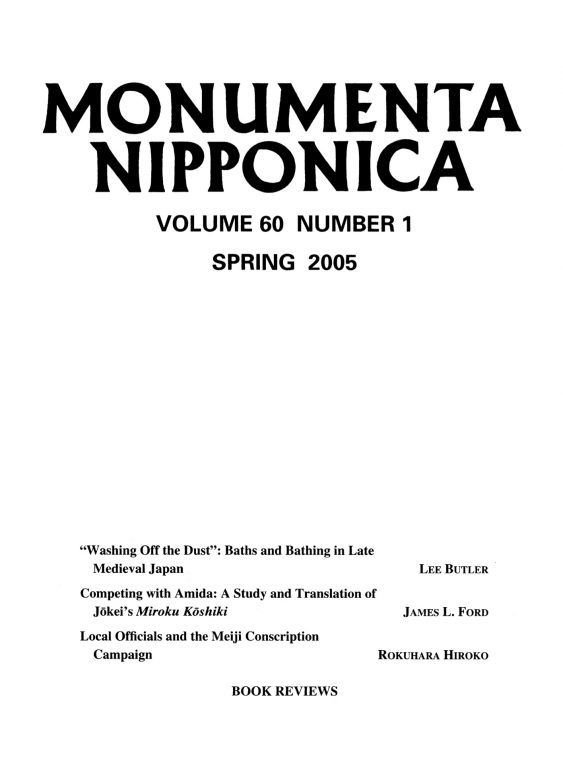 MN 60:1 (2005) 1–41“Washing Off the Dust”: Baths and Bathing in Late Medieval JapanLee A. Butler
MN 60:1 (2005) 1–41“Washing Off the Dust”: Baths and Bathing in Late Medieval JapanLee A. Butler MN 60:1 (2005) 43–79Competing with Amida: A Study and Translation of Jōkei’s Miroku KōshikiJames L. Ford
MN 60:1 (2005) 43–79Competing with Amida: A Study and Translation of Jōkei’s Miroku KōshikiJames L. Ford MN 60:1 (2005) 81–110Local Officials and the Meiji Conscription CampaignHiroko Rokuhara
MN 60:1 (2005) 81–110Local Officials and the Meiji Conscription CampaignHiroko Rokuhara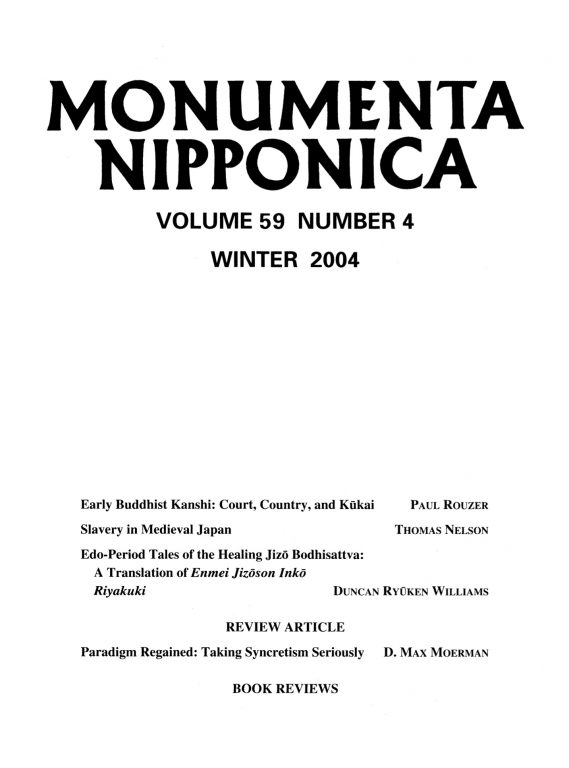 MN 59:4 (2004) 431–61Early Buddhist Kanshi: Court, Country, and KūkaiPaul Rouzer
MN 59:4 (2004) 431–61Early Buddhist Kanshi: Court, Country, and KūkaiPaul Rouzer MN 59:4 (2004) 463–92Slavery in Medieval JapanThomas Nelson
MN 59:4 (2004) 463–92Slavery in Medieval JapanThomas Nelson














